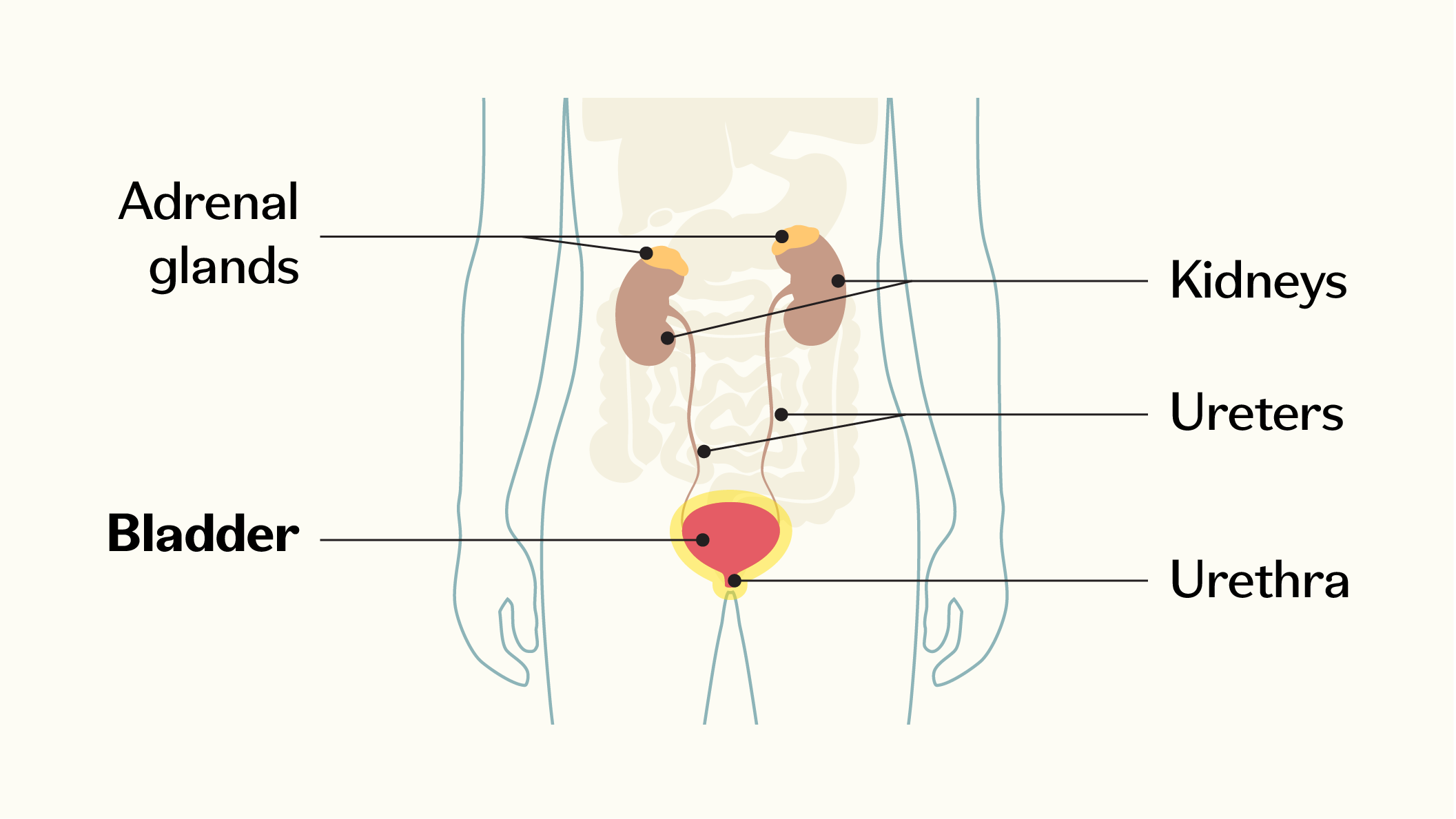The bladder
The bladder is a balloon-like organ that holds urine (wee) before we empty it. It is made of stretchy muscle and has 4 layers.1

How bladder cancer starts
Cells are the building block for every part of your body.2 Bladder cancer begins when abnormal cells within the bladder begin to grow and divide uncontrollably. When this happens, a cluster of cells forms. This is called a tumour.1
Factors such as smoking, coming into contact with certain chemicals, and chronic (long-term) bladder inflammation can increase the chances of getting bladder cancer. While anyone can develop bladder cancer, it is more common in men and in people over the age of 60.3
In the UK, over 10,000 people are diagnosed with bladder cancer each year.*1
*Estimate based on data from people diagnosed with bladder cancer in the UK between 2016 and 2018.
Types of bladder cancer
Bladder cancer is often described depending on where in the bladder it starts:1,4
There are a few types of bladder cancer. The most common type is an Non-muscle invasive bladder cancer (NMIBC) called urothelial carcinoma. Around 9 in every 10 people (around 90%) diagnosed with bladder cancer have this type.4
The cancer is only found in the inside lining of the bladder, or in the connective tissue that wraps around the inner lining.1,4
The cancer has grown outside of the inner layer and connective tissue, into the muscle layer on the outside of the bladder.1,4
There are also less common types of bladder cancer, such as squamous cell carcinoma and adenocarcinoma. These rarer forms can be more aggressive and might require different treatments.4
Treatment options for bladder cancer
Treatment is usually chosen based on the type of bladder cancer, what stage it is (how far it has grown within the bladder or if it has spread to another part of the body), and the person’s general health.5
Here are some common treatments for bladder cancer:
- Surgery: This is usually the first treatment given for bladder cancer. Doctors will either take out the tumour, or they will take out part or all of the bladder5,6
- Intravesical therapy: This involves medication, usually chemotherapy, being given directly into the bladder through a tube called a catheter. It targets cancer cells in the bladder lining and can reduce the risk of the cancer coming back5
- Chemotherapy: This involves using anti-cancer drugs that kill fast-growing cancer cells5,7
- Radiation therapy: This uses high-energy rays to kill cancer cells. It is often given with other treatments to improve its effectiveness, especially for people who are not suitable for surgery5
- Immunotherapy: This treatment works by using the body’s immune system to fight cancer5
Your treatment plan will be specific to you. It’s important to speak with your healthcare team to fully understand your options and what to expect from your treatment.
Remember that support is available and you’re not alone in this experience.

If you or someone you know has been diagnosed with cancer, support groups and charities are great places to find information and connect with people going through a similar experience.

Life with cancer is different for everyone. So, if you need support, it should be personal to you. ByYourSide has been created by Pfizer to offer you practical support and guidance to help you manage life with cancer in a way that is best for you.
References
- Cancer Research UK. What is bladder cancer. Available at: https://www.cancerresearchuk.org/about-cancer/bladder-cancer/about [Accessed May 2025].
- National Library of Medicine. Why is genetics important to my family and me? Available at: https://www.ncbi.nlm.nih.gov/books/NBK115604/ [Accessed May 2025].
- Macmillan. Causes and risk factors of bladder cancer. Available at: https://www.macmillan.org.uk/cancer-information-and-support/bladder-cancer/causes-and-risk-factors-of-bladder-cancer [Accessed May 2025].
- Cancer Research UK. Types of bladder cancer. Available at: https://www.cancerresearchuk.org/about-cancer/bladder-cancer/types-stages-grades/types [Accessed May 2025].
- Macmillan. Treatment for bladder cancer. Available at: https://www.macmillan.org.uk/cancer-information-and-support/bladder-cancer/treatment-for-bladder-cancer [Accessed May 2025].
- Macmillan. Transurethral resection of a bladder tumour (TURBT). Available at: https://www.macmillan.org.uk/cancer-information-and-support/treatments-and-drugs/transurethral-resection-of-a-bladder-tumour-turbt [Accessed May 2025].
- Macmillan. Intravesical chemotherapy for bladder cancer. Available at: https://www.macmillan.org.uk/cancer-information-and-support/treatments-and-drugs/intravesical-chemotherapy-for-bladder-cancer [Accessed May 2025].
